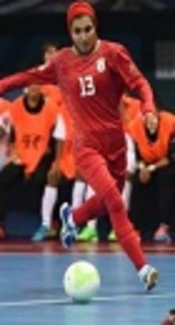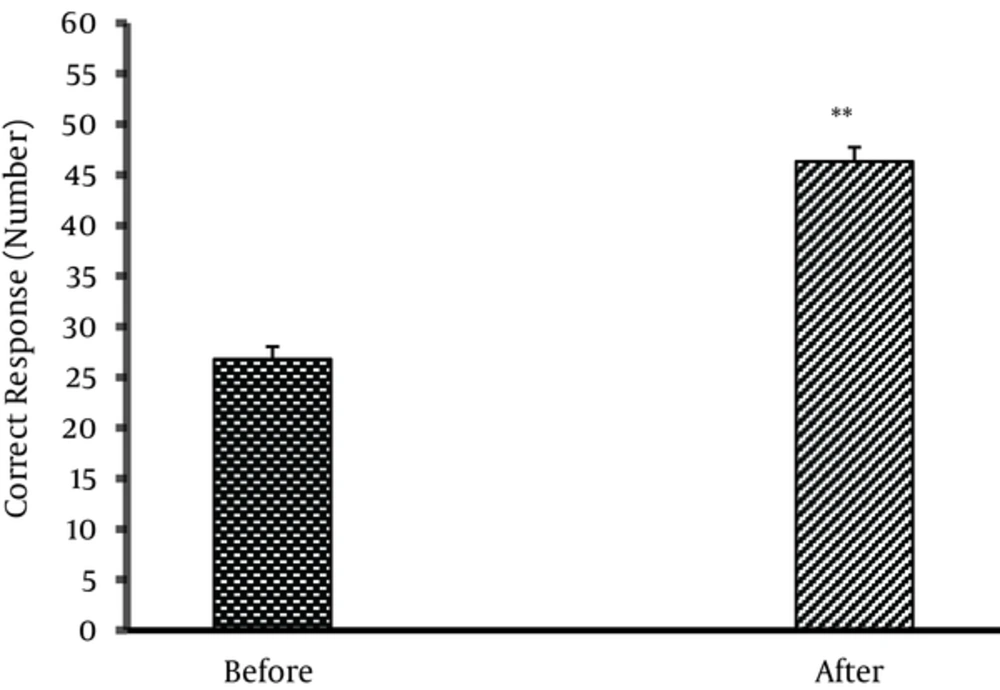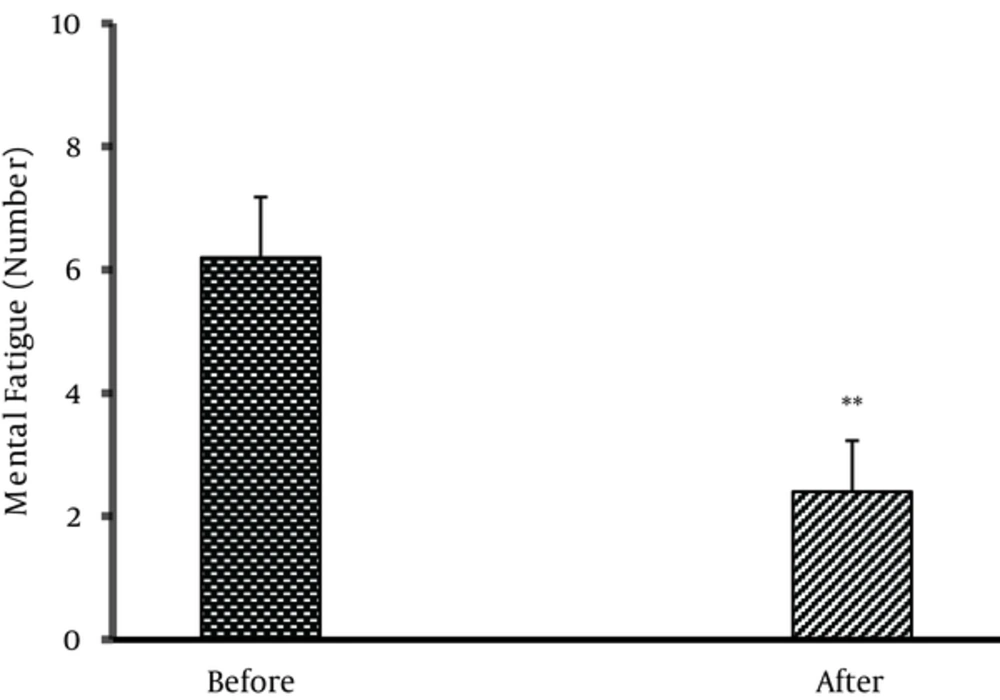1. Background
Recent theories insist that stress could be considered as the state of mind, which recruits both brain and body responses (1). Several adaptive changes, including secretion of cortisol and catecholamine, occur in response to stress, which could change the living organisms’ behavior. This response to stress varies from person to person and reflects genetic variations and individual health behaviors, such as diet, physical activity, and sleep (2).
Moreover, it has been shown that stress hormones, e.g. cortisol, released during stressful events could change the structure and cyto-architecture of the neurons in several parts of the brain, including the hippocampus (3). The hippocampus is considered as the main part of the brain involved in cognitive functions of humans, such as working memory, which may be affected by acute and/or chronic stress (4). Many studies have been carried out regarding the effects of stress on the brain, all showing that hippocampus is highly vulnerable to stress, maybe due to the high density of glucocorticoid receptors in the hippocampus (3, 5-7).
It has also been shown that one of the brain areas in humans affected by stress is the prefrontal cortex (8). As a matter of fact, studies carried out using functional brain imaging show that some parts of the prefrontal cortex are engaged in many tasks related to working memory and basic cognitive functions, such as attention and task management. Other parts of the prefrontal cortex may also play a role in the specific types of working memory (3, 9). Several types of sensory stimulus, especially auditory ones, could be used appropriately as stimuli for evaluating sensory motor performance and summarizing capacity of the cortex. This is due to the fact that their responses are a type of speech that is mixed with summarizing and thinking (10).
Paced auditory serial test (PASAT) is a simple test used by neuropsychologists to study consciousness processes (10). In fact, it is a tool used in studying immediate memory and attention, in which the stimulation is auditory and/or visual (11). The main reason behind the development of PASAT was to assess the influence of brain lesion on cognitive function of the brain in soldiers or patients with wide and various ranges of neurological and psychological syndromes. However, several studies have been carried out by this software for assessing cognitive functions under different conditions, including time change (12), diving (13), and sport (14). These experiments have proved that PASAT is a useful tool for assessing the effect of stress on cognitive function. Nevertheless, it is still not clear what might happen if an acute mental stress is applied to a voluntary. Since the stress system is more sensitive in females than males (15), and one of the mental stressful situations is match requiring several cognitive performances, this study attempted to organize an experiment in real era in order to examine the cognitive performances in female futsalists before and after the match.
2. Objectives
In this study, due to the importance of cognitive performance in athletes, the effect of possible mental stress on the cognitive function of female futsal players was studied.
3. Methods
Ten female futsal players from Pol-e Dokhtar, Lorestan province, in the west of Iran, participated in the study with an average age of 20 ± 2 years. It should be noted that they were selected after being examined by a psychiatrist and neurologist. Indeed, they neither had any underlying disease in the auditory system nor any problem in speaking. Besides, they did not take any medication, except for acetaminophen and other common steroidal anti-inflammatory drugs, such as aspirin, and did not abuse any drug.
Moreover, their hearing ability was tested by an audiometric test. Their average weight and height were 55.2 ± 3.5 Kg and 162.7 ± 5 cm, respectively. Their academic level ranged from diploma to Bachelor of Science (BSc). Since the participants lived in camps, their diet was also similar.
One day prior to the test, the participants were instructed regarding how to perform the test. They were, indeed, tested using PASAT on January 28th, 2013 between 8:00 am and 9:00 am before a match in women’s futsal league of Lorestan Province. Saliva samples were taken from all participants to determine their salivary cortisol level. Moreover, after match ending, they were tested by the PASAT software for the second time between 11:30 and 12:30. Saliva samples were also taken again.
The PASAT software test was, in summary, as follows. The participants were administered a test composed of 61 digits ranging from 1 to 9, randomly, with an interval of 3 seconds. Before being provided with the third number, the participant had to add up the two last numbers in the series and give the answer. For example, if numbers 2 and 6 were given to the participant, the correct answer would be 8. The accuracy of responses was defined as the number of correct answers for every subject. The participants’ responses were compared before and after the match.
In addition, general mental health was calculated by the software as the total correct answers, and reaction time (calculated by the software), sustained attention (defined as the longest series of correct responses calculated by the experimenter), and mental fatigue (defined as the longest series of wrong responses, also calculated by the experimenter) were measured as indicators of the participants cognitive function (11). For measuring salivary cortisol, an enzyme linked immunosorbent assay (ELISA) Kit was exploited (Cortisol ELISA kit, Diagnostics Biochem Canada Inc, dbc). In order to carry out this test, saliva samples were collected and kept in 10-mL falcon tubes. Then, they were kept in a freezer at -20°C, and for cortisol assessment, 50 micro liters of each sample was separated for the test after being centrifuged for 5 minutes with a spinning speed of 3000 per minute.
Results were analyzed by SPSS software version 16. Data were expressed as mean ± Standard Error of the Mean (SEM). Paired t test was exploited to determine the significance of differences before and after the match. P values of < 0.05 were also considered statistically significant.
4. Results
4.1. Comparing Salivary Cortisol Concentration Before and After the Match
The results showed that salivary cortisol before the match was significantly higher than its concentration after the match (t9 = 9.78, P < 0.05) (Figure 1).
4.2. Comparing General Mental Health Before and After the Match Using PASAT
The results showed that the general mental health (the number of correct responses) of the futsal players after the match was significantly higher than that before the match, (t9 = 11.59, P < 0.01) (Figure 2).
4.3. Comparing Average Response Speed Before and After the Match Using PASAT
The PASAT results showed that the average responding speed of the futsal players decreased significantly after the match (t9 = 5.64, P < 0.05) (Figure 3).
4.4. Comparing Sustained Attention Before and After the Match Using PASAT
As mentioned earlier, the longest series of correct responses is a criterion for measuring continuous attentiveness in PASAT. Results show that futsal players’ continuous attentiveness increased significantly after the match (t9 = 7.32, P < 0.05) (Figure 4).
4.5. Comparing Mental Fatigue Before and After the Match Using PASAT
In PASAT, the longest series of wrong answers reflects mental fatigue. Results show that futsal players’ mental fatigue decreased significantly after the match (t9 = 8.14, P < 0.01) (Figure 5).
5. Discussion
The current study investigated the influence of mental stress arising by match sensitivity on cognitive functioning in female soccer players. Females were chosen because their stress system was more sensitive than males (15). Low sample size (n = 10 in each group) was one of the limitations of the study, which may raise the issue that a greater sample size would change the results. However, two points, in this regard, should be taken into account. First, as the parameters in the study are quantitative, the sample size would not have any effect on the results. Second, high sensitivity tools were used in this study with the PASAT software and ELISA method to discover and identify, even, the minor differences. Since coordination is an important factor in achieving success in team work, especially in sports, proper cognitive functioning of players is a determining factor in forming coordination between players. The data showed that salivary cortisol was elevated before the match and, then, reduced after the match indicating that stress system was activated in the athletes.
Previous studies have revealed that exposure to stressful events could excite the stress system namely the hypothalamus-pituitary-adrenal (HPA) axis and, thereby, plasma glucocorticoid hormones (cortisol in human and corticosterone in rodents) increase (16). Plasma cortisol level increment, in fact, increases organism readiness to the stressor (17). In agreement with this view, increased salivary cortisol indicates that the match is a stressful event for players in this study. Previous investigations have also shown that cortisol and corticosterone could easily cross the biological barriers, and be detected in the plasma and other body liquids, including the saliva (17) The very cortisol increment is considered as one of the causes of disorientation in mental activity (18). On the other hand, the high concentration of glucocorticoids caused by stress effects parts of the brain involved in emotional responses, such as lateral amygdala (19). Therefore, some believe that people exposed to stress suffer from impaired memory capacity, cognitive ability, and decision-making skill, yet their emotional behaviors are strengthened (20). However, one may postulate that the results may be due to a chronic rather than acute stress, which the players experienced. Therefore, it should be noted that, in this experiment, the brain ability increased after the match, and salivary cortisol also declined dramatically. These findings exclude the above-mentioned hypothesis, and show that the results are due to an acute stress.
Interestingly, there was a lower level of attention and response speed, and, also, a higher level of mental fatigue. These results were in line with an increase in salivary cortisol concentration in athletes before the match. The other interesting point here was that, maybe, due to the match stress, athletes showed higher salivary cortisol before the match (21). With taking destructive effects of stress on cognitive function into account, it could be suggested that the reason behind the repetitive errors in the PASAT software test might be the very high level of stress hormone (6). The responses were highly in line with a high level of cortisol plasma. In other words, the high stress level before the match seems to decrease the ability to sense environmental changes. If this is the case, the individual will not be able to accurately analyze his/her environmental changes. At last, although our study was performed in female futsalists, the researchers suggest that this study must be repeated in the male athletics as well, since this could further expand the knowledge of the effect of acute mental stress on cognitive function.
5.1. Conclusions
Generally, it could be concluded that an increase in an individual’s stress system is caused by the stress before the match, which is shown by higher salivary cortisol level, and leads to impairment of cognitive system and an increase of his/her errors, as shown by parameters measured by PASAT.





